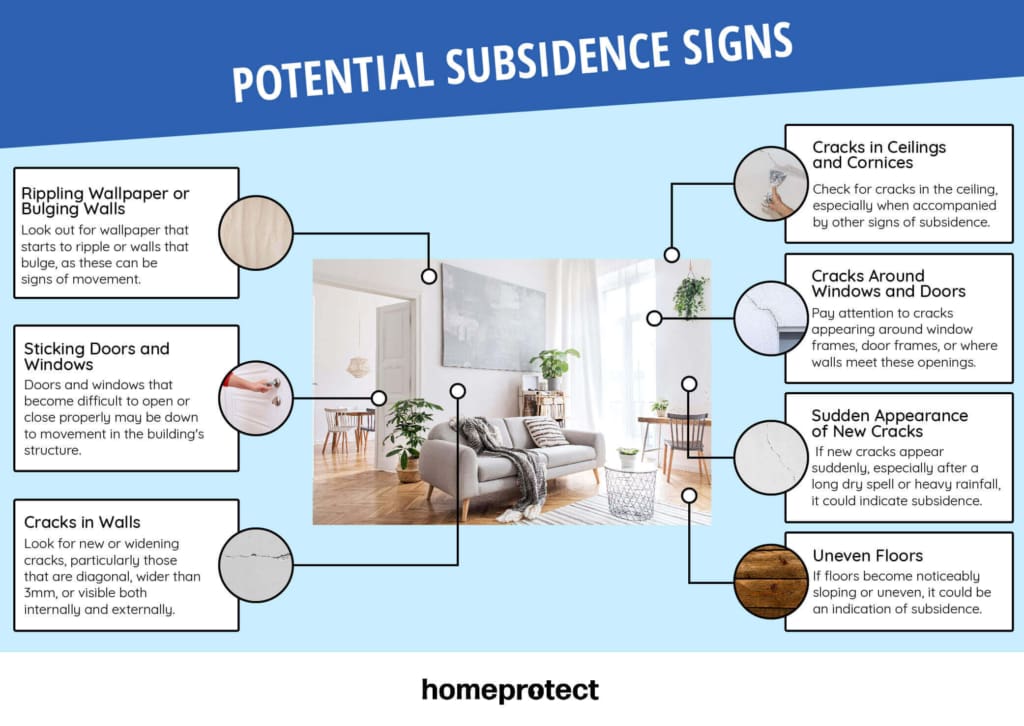Our Comprehensive Guide to Subsidence
Subsidence can be a serious worry for homeowners – especially those noticing the sudden appearance of cracked walls, or prospective buyers looking for a long-term place to live that won’t saddle them with unexpected bills.
But what is subsidence, how does it impact homes and what are the signs?
Our home insurance experts explain all in this comprehensive guide to subsidence, including how to use techniques such as underpinning to potentially remedy the issue.
What Is Subsidence?
Subsidence refers to the downward movement or sinking of the ground beneath a building, which can result in the shifting or tilting of the structure.
It is a common issue when the soil beneath a house loses its stability or support, causing the foundations to shift or sink unevenly.
What Causes Structural Movement?
Structural movement is more commonly found in old buildings and can be caused by various factors, including:
- Changes in Soil Moisture Content: Significant changes in soil moisture levels, such as prolonged drought or excessive rainfall, can cause the soil to shrink or swell, leading to subsidence.
- Soil Composition: Certain types of soil, such as clay, can shrink or expand more than others in response to moisture changes, making them more susceptible to subsidence.
- Underground Mining Activities: If there are abandoned mines or tunnels near a property, subsidence can occur as the underground voids collapse or shift.
- Poorly Compacted Fill Soil: If the soil used in construction is not properly compacted or is of low quality, it can compress over time, resulting in subsidence.
For more information, read our guide on the common causes of subsidence.
Signs of Subsidence in the Home

The possible signs of subsidence to look out for in your home include:
- Cracks in Walls: Look for new or widening cracks, particularly those that are diagonal, wider than 3mm, or visible both internally and externally.
- Cracks Around Windows and Doors: Pay attention to cracks appearing around window frames, door frames, or where walls meet these openings.
- Cracks in Ceilings and Cornices: Check for cracks in the ceiling, especially when accompanied by other signs of subsidence.
- Uneven Floors: If floors become noticeably sloping or uneven, it could be an indication of subsidence.
- Sticking Doors and Windows: Doors and windows that become difficult to open or close properly may be down to movement in the building’s structure.
- Rippling Wallpaper or Bulging Walls: Look out for wallpaper that starts to ripple or walls that bulge, as these can be signs of movement.
- Sudden Appearance of New Cracks: If new cracks appear suddenly, especially after a long dry spell or heavy rainfall, it could indicate subsidence.
How To Fix Subsidence – A Step-By-Step Guide
Fixing subsidence requires a systematic approach and often involves professional assistance.
If you suspect you may have subsidence in your home, below is a step-by-step guide on what to do:
- Identify The Signs: Look for signs of subsidence in your property, such as cracks in walls, sticking doors/windows, or uneven floors. Confirm these are signs of subsidence and aren’t caused by other factors. It’s important to distinguish between property subsidence and settlement before continuing with any fixes.
- Consult a Professional: Contact a qualified structural engineer or building surveyor who specialises in subsidence. They will assess the extent and cause of the subsidence, investigate any history of subsidence in the area, and recommend appropriate remedial measures.
- Investigate the Cause: The professional will investigate the underlying cause of subsidence. This may involve soil analysis, ground surveys, and examining drainage or nearby construction activities.
- Implement Temporary Measures: In some cases, temporary measures may be required to stabilise the property and prevent further damage. This can include installing props or supports to relieve pressure on the affected areas.
- Address the Underlying Cause: Facing the cause of subsidence head-on is essential for long-term stability. The appropriate solution will depend on the specific circumstances but may involve actions such as:
- Soil Stabilisation: Treating or improving the soil to prevent further movement. This may include techniques like soil injection or ground reinforcement.
- Drainage Improvements: Establishing proper drainage to prevent excessive moisture accumulation or soil erosion.
- Tree Management: If trees are contributing to subsidence, their removal or root barrier installation may be necessary.
- Underpinning: In severe cases, underpinning may be required. This involves strengthening the foundations by extending it deeper into stable soil layers.
- Obtain Necessary Permissions: Depending on the extent and nature of the repairs, you may need to obtain necessary permissions or consent from local authorities or relevant organisations.
- Hire Qualified Contractors: Hire experienced and reputable contractors who specialise in subsidence repairs. Make sure they have the expertise and necessary certifications.
- Carry Out the Repairs: The chosen repair method will be implemented by the contractors. This may involve excavation, foundation strengthening or other specialised techniques.
- Monitor and Reassess: After the repairs, it’s important to monitor the property for any further signs of movement. Regular inspections can help monitor the effectiveness of the repairs and detect any new issues early on before they cause further damage. Insurers will need a specific list of accurate and updated information on the issue.
- Review Insurance Coverage: Check your insurance policy coverage to understand if subsidence-related repairs are included. Notify your insurer of the situation, so all underwriters can calculate any subsidence risks and adjust your premiums accordingly.
For further details on subsidence and its impact on home insurance, Homeprotect provides an additional step-by-step insurance guide.
How Can You Prevent Subsidence in The Future?
While it may not be possible to eliminate the risk of subsidence, there are several measures you can take to minimise the likelihood of it occurring in the future:
- Maintain a Stable Moisture Level: Maintain proper drainage around your property to prevent excessive water accumulation near the foundations. Regularly inspect and maintain gutters, downspouts and drainage systems to redirect water away from the building.
- Manage Trees and Vegetation: Plant trees and large shrubs at a safe distance from the property, especially if they have extensive roots that may interfere with the foundations. Consult an arborist for guidance on appropriate tree species and planting distances.
- Monitor and Manage Soil Moisture: Regulate the moisture levels in the soil around your property. Avoid over-watering or allowing the soil to become excessively dry, as either extreme condition can contribute to soil movement. Consider using irrigation systems that maintain a consistent and controlled level of moisture.
- Seek Professional Advice: If you notice any signs of subsidence, or have concerns about your property’s stability, consult a qualified structural engineer or building surveyor immediately. They can assess the situation, identify potential risks and provide recommendations for preventative measures or early intervention.
- Obtain Professional Reports: When buying a property, consider obtaining a structural survey or homebuyer’s report from a qualified professional. This can help identify any existing or potential subsidence issues before making a purchase.
For more information, read our guide on how to prevent subsidence.





